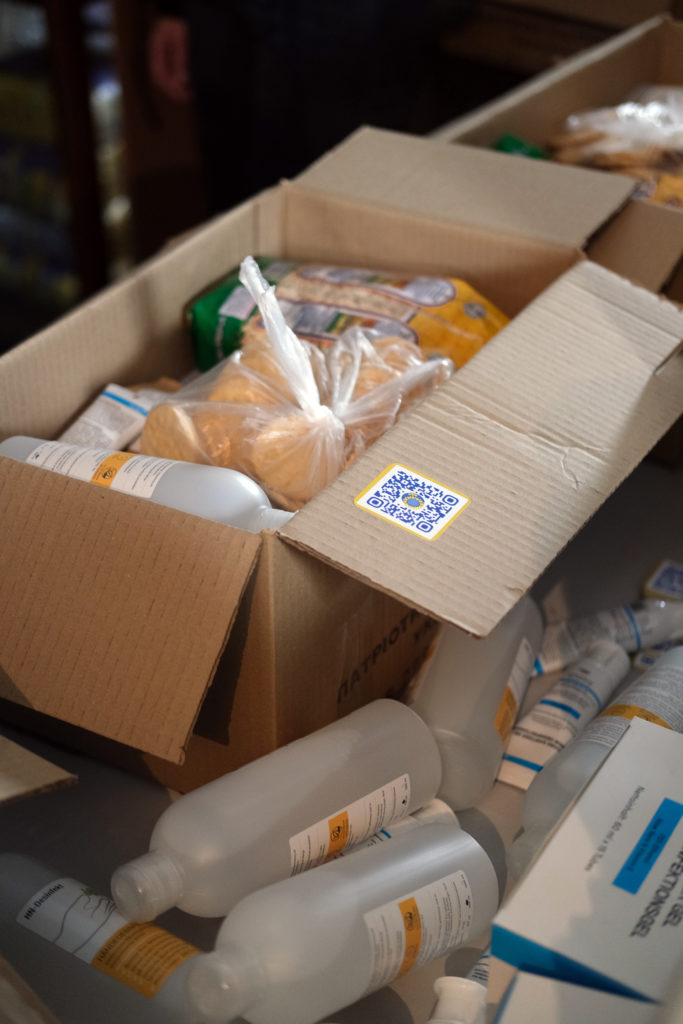What do you do when you want to plant a church in a new area, but travel is restricted? How do you know where in the city to plant the church and how to generate interest when canvassing and prayer walking aren’t possible?
Missionaries with the International Mission Board are employing digital engagement as a new entry strategy for planting churches. IMB missionary Brant Bauman uses evangelism ads and QR code stickers on humanitarian relief packages to point people in Eastern Ukraine to an evangelism resource website.

A Ukrainian man checks the messages on his phone. IMB digital engagement strategies seek to make connections with Ukrainians in their hour of need. IMB Photo
Paving the way for new churches
IMB missionaries and Ukrainian Baptist pastors hope to plant churches in two cities in far eastern Ukraine — a region under an onslaught from Russia. Great need is coupled with great devastation in these areas, but people are coming to faith. Evangelism efforts are reaching the lost.
In many locations, prayer walking and canvassing neighborhoods to meet people and invite them to visit are strategies to help a church plant. Given the dangers that come with war, this isn’t possible in Ukraine. Instead IMB missionaries are engaging these cities through digital media.
Hope for Ukraine is a website launched by the IMB in the spring of 2022 to provide gospel resources, links to download a digital Bible and a chat feature where Ukrainians can reach out for prayer.
Bauman helped create the website, which opened the floodgates for digital engagement in Ukraine and Europe. Bauman and his team are running evangelism video ads in the cities where IMB missionaries hope to plant churches. Almost 12,000 people have watched the videos to completion, which is a large number given the size of the towns.
He is hoping the videos will help “prime the pump” so that when church planters arrive, the ground will be extra fertile.
Bauman recently traveled to Ukraine with fellow IMB missionary Mike Domke, who served in Ukraine before evacuating during the onset of the war. They traveled to visit partners, check on Send Relief projects and for Bauman to connect with digital first responders who answer when someone contacts the website and investigate future opportunities for digital engagement.
He’ll continue to look for ways to propel the work of church planters forward faster and further despite the limitations they experience because of the war. Bauman said they plan to continue running the video ads in the area, and they are looking at using this strategy in other countries.
Humanitarian aid is another way digital engagement is pushing the gospel forward.
Stickers make gospel connections
Send Relief has facilitated 98 projects to serve Ukrainians. In Ukraine, there have been 45 projects, with 35 of them still in progress.
But as they try to aid Ukrainians in a humanitarian way, Bauman said, “what we primarily know is that the greatest need is the gospel because the greatest problem is lostness.”

QR code stickers attached to disaster relief boxes point people to the Hope for Ukraine website. The website hosts gospel materials and a chat feature to reach out to Christians. IMB Photo
Bauman said his trip was eye-opening, and it quickly became evident to him that God is on the move. His goal was to determine how to get people the resources they need. They asked themselves, how do we incorporate the gospel into humanitarian relief?
An ongoing method of digital engagement is affixing QR code stickers to humanitarian boxes being sent to eastern Ukraine. Nine hundred boxes were shipped in a single day. Bauman said attaching a sticker increases the likelihood someone will see it, because brochures may be lost or discarded. With a scan of the QR code, people can have access to the gospel message.
Since the launch of the Hope for Ukraine website, QR codes leading to the website have been scanned 626 times.
Bauman said they will continue to look for ways to intertwine digital engagement with Send Relief. He hopes the opportunities resulting from digital engagement opened in Ukraine will be an example for other cities.
“We want to continue to be faithful to let this be a shining example of how God is working in and through digital engagement strategies,” Bauman said. “If we give God the ability to work in all ways and through every means possible, He comes through.”

